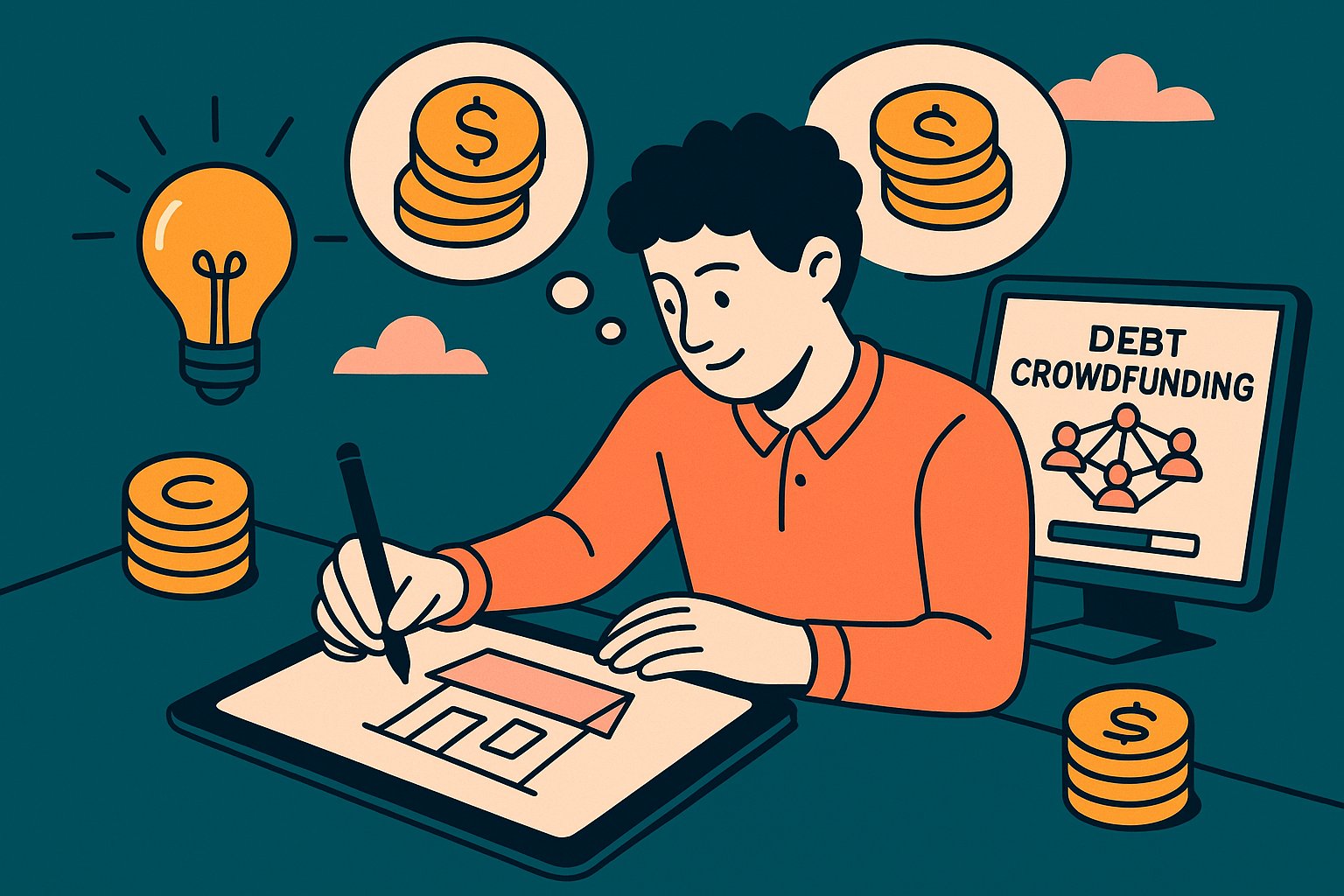Stepping onto the Debt Crowdfunding Stage
Debt crowdfunding has surged in popularity as a versatile financing option for creators seeking capital without relinquishing equity. Before diving headfirst into this dynamic landscape, it’s essential for every creator to understand the fundamentals, identify potential pitfalls, and craft a strategy that resonates with prospective lenders. This guide—Debt Crowdfunding 101: What Every Creator Needs to Know Before Borrowing—will walk you through the core principles, practical considerations, and forward-looking trends that will empower you to launch a successful debt crowdfunding campaign. By mastering these insights, you can position your project for funding, build credibility, and navigate the responsibilities that come with borrowing from a community of backers.
What Debt Crowdfunding Really Means
At its heart, debt crowdfunding—also known as peer-to-peer lending—allows creators to borrow money from a broad network of individual investors rather than from traditional financial institutions. Unlike equity crowdfunding, in which contributors receive a stake in your venture, debt crowdfunding obligates you to repay the principal plus interest within a predetermined timeframe. This model appeals to creators who wish to retain full ownership and control of their project while accessing capital on potentially favorable terms.
Before you begin, consider why debt crowdfunding could suit your goals. If you have a clear revenue model, predictable cash flow, and confidence in repaying backers, debt crowdfunding can offer quicker access to funds and more flexible terms than bank loans or venture capital. However, the obligation to repay—regardless of your project’s market performance—means you must plan diligently, forecast realistic income, and prepare for contingencies. Understanding this dual promise and responsibility is the first step toward a successful campaign.
Gauging Your Readiness: Assessing Eligibility and Financial Health
A debt crowdfunding platform will scrutinize your creditworthiness, project viability, and repayment capacity. In essence, you are asking strangers to trust you with their money, so demonstrating credibility is crucial. Begin by conducting an honest self-assessment of your financial health: review your personal and business credit scores, evaluate monthly cash flow projections, and calculate your debt-to-income ratio. Platforms often require a minimum credit score (commonly in the mid-600s) and proof of steady income or revenue streams to mitigate risk for lenders.
Beyond credit, your project itself must convey viability. Whether you’re developing an independent film, launching a handcrafted jewelry line, or manufacturing an innovative gadget, you need a clear, realistic business plan. Outline your total funding needs, explain how those funds will be allocated, and forecast revenue that demonstrates your ability to meet repayment schedules. When you address these criteria upfront, you’ll not only improve your chances of approval but also illustrate to potential backers that their investment is grounded in a thoughtful strategy rather than wishful thinking.
Crafting a Compelling Narrative That Resonates
Even with strong financials, you must connect emotionally with potential lenders. A compelling narrative does more than describe numbers; it highlights the creative spark, mission, and passion behind your project. Begin by articulating why you embarked on this venture—whether it’s your lifelong dream to create socially conscious art, a solution you’ve developed to solve a tangible problem, or a vision for community building. Explain the impact your project will have, both for your target audience and the broader ecosystem.
In this storytelling process, avoid generic statements. Instead of saying “I need funds to produce an album,” illustrate how your music will uplift underrepresented voices and foster community engagement. Use concrete anecdotes: describe late-night studio sessions, the inspiration drawn from a specific life experience, or the collaborative energy you’ve already built. By humanizing your project, you cultivate trust and enthusiasm, transforming passive onlookers into active lenders who believe in your creative journey as much as the financial return.
Defining the Right Funding Goal: Balancing Ambition and Realism
Determining the precise amount to ask for can make or break your campaign. Underestimating your needs can lead to budget shortfalls, while overreaching could scare off cautious lenders. Start by itemizing all project expenses—production costs, marketing, distribution, and platform fees—then add a buffer for unexpected contingencies (typically 10 to 15 percent of your total budget). This comprehensive calculation demonstrates foresight and reassures backers that you’ve accounted for potential hiccups.
Equally important is setting an interest rate and repayment term that reflect market conditions and your revenue projections. Research typical rates on your chosen platform; these might range from 5 to 15 percent annually, depending on risk profiles and loan durations. Consider shorter terms (six to 12 months) if you anticipate rapid revenue generation, thereby minimizing long-term interest obligations. Conversely, if your project requires time to gain traction, longer repayment periods (up to three years) may ease monthly payments, though they may also come with higher interest costs. Clearly explain these decisions in your campaign narrative, demonstrating that you’ve struck an equilibrium between ambition and financial prudence.
Navigating Platform Selection: Finding Your Best Match
There’s no one-size-fits-all when it comes to debt crowdfunding platforms. Some cater to specific industries—like creative arts, technology, or social enterprises—while others serve a broad range of borrowers. Evaluate platforms based on fees, user base size, application requirements, and additional resources (such as marketing tools or mentorship programs). Common platforms include Kiva for low-interest social impact loans, LendingClub for small business funding, and FundingCircle for established enterprises. Each option carries its own application process, interest rates, and repayment flexibility.
When researching platforms, pay close attention to their success rates and borrower feedback. A platform that consistently funds projects similar to yours offers a higher likelihood of reaching your goal. Additionally, consider how involved the platform is in vetting projects: some provide underwriting services that pre-qualify you, while others rely heavily on your own pitch to attract lenders. Assess platform fees—origination fees can range from 1 to 5 percent of the funded amount—and ensure you factor these costs into your budget. By selecting the right platform, you align your project with a community predisposed to support your creative vision.
Building Trust with Transparency and Regular Communication
In debt crowdfunding, trust is paramount. You’re effectively creating a network of informal creditors who expect timely repayment, so nurturing transparency from the outset is essential. Disclose any relevant financial history and explicitly outline how funds will be used. If there are risks—such as production delays, supply chain issues, or evolving regulatory landscapes—address them candidly. Lenders respect candor more than overly optimistic projections that feel disconnected from reality.
Once your campaign is live, maintain open lines of communication. Regular updates—whether weekly progress reports, behind-the-scenes photos, or short video messages—reinforce accountability. If you hit a roadblock, inform your backers immediately, detailing the challenge and your contingency plan. Conversely, celebrate milestones as you reach funding thresholds or achieve initial project benchmarks. Engaging your lender community not only strengthens credibility but can also extend your network through word-of-mouth referrals. When investors feel part of your journey, they become ambassadors who champion your project to their peers.
Post-Campaign Responsibilities: Managing Your Repayment Obligations
Securing funding marks a pivotal milestone, but the journey doesn’t end once your campaign succeeds. Repaying backers on schedule is critical to preserving your reputation and laying the groundwork for future financing. Begin by creating a detailed repayment calendar—documenting due dates, principal amounts, and interest obligations—to ensure predictable cash flow management. If your project generates revenue, allocate incoming funds strategically so that operational costs don’t impede timely loan repayments.
In cases of unexpected setbacks—such as slower sales, production overruns, or tax adjustments—communicate proactively with your lenders. Offer transparency around revised timelines and provide clear explanations for any delays. Some platforms allow you to refinance or extend repayment terms, but these options often come with additional fees. By demonstrating responsibility and a commitment to your obligations, you build goodwill that can unlock future borrowing opportunities. Remember, reputation in the crowdfunding community can make or break your next venture.
Risk Mitigation and Legal Considerations
Borrowing through debt crowdfunding carries inherent risks, both financial and legal. As a creator, you must familiarize yourself with the regulatory landscape governing peer-to-peer lending. In the United States, platforms typically fall under the purview of the Securities and Exchange Commission (SEC) or other federal and state regulators. Ensure that your chosen platform complies with relevant lending laws, including disclosure requirements and interest rate caps. If your campaign involves backers across multiple jurisdictions, you may face additional regulations—international lending rules, currency conversion complexities, and tax reporting variations. Consulting with a lawyer experienced in crowdfunding can prevent inadvertent noncompliance.
From a financial standpoint, never borrow more than you can realistically repay. High interest costs or extended repayment timelines can erode your profits and strain operational budgets. Consider alternative or hybrid financing solutions—such as combining a smaller debt crowdfunding round with equity or grant funding—to spread risk. Additionally, factor platform fees, payment processing charges, and potential defaults into your breakeven analysis. By conducting thorough legal and financial due diligence, you safeguard both your creative ambitions and long-term financial health.
Leveraging Marketing Strategies to Maximize Visibility
While financial planning and platform selection are critical, your campaign’s success ultimately hinges on visibility and public interest. Effective marketing can distinguish your project from hundreds of contemporaneous campaigns. Start by identifying your target audience—consider demographics, interests, and online behavior—and tailor your messaging accordingly. Develop a pre-launch marketing plan that includes email outreach to your existing contacts, social media teasers, and collaborations with influencers who align with your niche.
During your campaign, maintain a multi-channel approach. Regular blog posts, live-streamed Q&A sessions, and guest articles on industry publications can amplify your reach. Use data analytics to track engagement metrics—click-through rates, share counts, and conversion ratios—to refine your outreach and focus on the most effective channels. Remember to optimize your campaign page for SEO: include keywords like “debt crowdfunding,” “creative financing,” and “peer-to-peer loans” in your title tags, meta descriptions, and body text. Eye-catching headlines, relevant subheaders, and concise call-to-action statements encourage potential backers to explore your project further.
Measuring Success and Charting Future Growth
Once you’ve secured funding and embarked on your creative endeavor, you’ll need to assess how effectively the borrowed capital fueled your goals. Define clear key performance indicators (KPIs)—such as revenue growth, production timelines, or user adoption rates—and measure them against your original forecasts. By comparing projected versus actual performance, you gain insights into which strategies excelled and where adjustments are necessary.
If your project exceeds expectations, consider how debt crowdfunding can serve as a launchpad for future initiatives. Positive repayment history and strong engagement metrics enhance your credibility, making subsequent funding rounds smoother. You might even explore hybrid approaches—combining debt crowdfunding with equity crowdfunding or grant applications—to accelerate expansion. Conversely, if obstacles arose, analyze root causes and integrate lessons learned into your next campaign. In either scenario, documenting your outcomes and sharing these findings transparently with your backers reinforces trust and nurtures a loyal community invested in your creative journey.
Charting Your Path to Financial Freedom
Debt crowdfunding can transform ambitious ideas into tangible realities, provided you approach it with careful preparation, thoughtful storytelling, and unwavering commitment. By grasping the foundational principles, assessing your financial health, and selecting the right platform, you position your project for success. Crafting a compelling narrative builds emotional resonance with backers, while transparent communication and diligent repayment management preserve trust and open doors for future funding. As you navigate legal considerations and implement targeted marketing, you’ll gain invaluable insights that sharpen your entrepreneurial acumen.
Ultimately, debt crowdfunding is not merely a financing mechanism—it’s a collaborative journey with a community that believes in your vision. With each repayment milestone, you demonstrate accountability; with each project update, you foster loyalty; and with each success, you inspire peers to embark on their own creative ventures. By following the strategies outlined in this guide, you’ll not only secure the funds you need but also cultivate a network of advocates who champion your work long after the debt has been repaid. Embrace this opportunity to borrow wisely, create boldly, and chart a path toward lasting financial empowerment.




